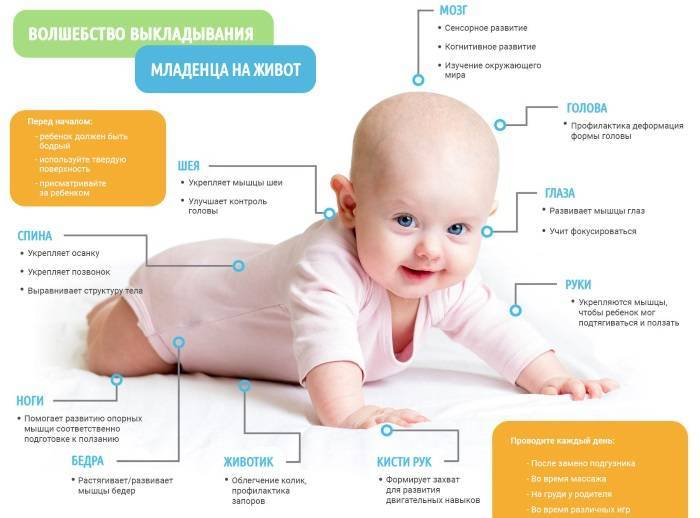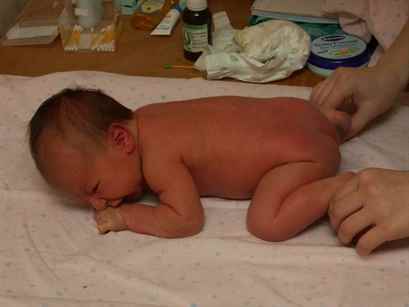IN THIS ARTICLE:
- Why doesn't a child like being laid on his stomach?
- Placing a newborn on the stomach: from what age?
- How to properly place a newborn and infant on the stomach?
Laying on the stomach is necessary for a newborn from the first day of life to gain strength, even if at first he is nervous and cries. Experts believe that without placing a baby on his stomach, he will experience delays in the development of motor skills.
Tummy time before feedings and throughout the day helps babies learn to lift their heads, roll over, sit, crawl and attempt to stand, according to Danette Glassie, chairwoman of the American Academy of Pediatrics Committee on Early Childhood Development and Care.
Place it on your tummy correctly
You can’t just pick up and turn the baby onto his stomach; a number of conditions must be met.
Since the situation is new for the vulnerable baby, mommy must do everything correctly and carefully. Adhere to the following rules: Place the baby on a hard and flat surface. Use a regular or changing table for this. You can cover the floor with a sheet or blanket and place the baby on it, as long as there are no drafts and the floor is warm. Solid support will help the baby develop motor skills. Before placing your baby on his belly, do not give him food. The position can provoke regurgitation, and after feeding, children want to sleep rather than exercise (see also: how to hold a newborn upright after feeding: video). Be sure to be close to the newborn. Do not allow the child to bury his nose in a blanket or pillow; remove them
Monitor his position, do not leave him unattended for even a minute - this is especially important for 2-3 months of age, when the child actively turns over on his own. Pediatricians advise placing a newborn on his tummy naked
Check how many degrees there are in the room where the child is, so as not to catch a cold.
Since the pose involves muscle training, never put your baby down after meals or before bed. The exercise is carried out only when the baby is awake.
Other options and expert advice
If all your efforts do not lead to a positive result, the baby continues to resist and does not want to lie on his stomach, offer him other options.
Regular activities with your child will lead you to success - especially since by a certain age children themselves begin to love not only lying down, but also sleeping on their stomachs. The once unloved position turns into the most convenient and comfortable.
Let's find out what Dr. Komarovsky's opinion is. The famous pediatrician strongly advises placing the baby on his stomach from the moment he is born. Parents who doubt their skills can watch a video of a doctor’s lesson, where everything is shown clearly and accessible. After reading all the recommendations, you will learn how to do it correctly, and after listening to the advice of the famous pediatrician, you can safely get down to business. Experiences and visual videos of other moms can also help.
Source: https://vseprorebenka.ru/razvitie/fizicheskoe/kogda-novorozhdennogo-mozhno-klast-zhivotik.html
When can a newborn be placed on his stomach?
Should a newborn baby be placed on his tummy? At what period can this be done - from birth or wait until the baby can hold his head well? How and what to entertain a baby who is lying on his tummy?
From the very first days, it is recommended to turn a newborn on his tummy. Neither the umbilical wound, which has not yet fully healed, nor the weakened neck will interfere with him. After the baby is born, he immediately ends up on his mother’s stomach. This is very useful for him:
- Babies are placed to sleep on their backs to avoid sudden infant death syndrome. Newborns spend a lot of time sleeping in the first months of their life, and this can cause the back of their head to assume a flat position. For prevention, the baby is placed on his tummy.
- The baby's accumulated gas comes out better if he is placed on his tummy for a while before feeding each time. This is also useful for preventing the occurrence of a hernia in the child’s navel.
- A child turned onto his tummy gradually loads his muscles so that the neck, shoulder girdle, arms and abdomen develop well. This physical activity is very useful for holding the head, developing sitting and crawling abilities.
- A child develops intellectually when he lies on his tummy, as he begins to see the world around him from a different angle, as well as feel it with his body.
How should a newborn be placed on his stomach?
- A flat and hard surface is needed to place the baby on his tummy. On a soft one, the baby will not be able to raise his head or even bury his nose and this can lead to suffocation. For this reason, all pillows and soft toys should not be near the baby.
- It is better to lay a diaper or towel on the selected surface so that the child can lie warmly and then he will be calm and will not cry.
- You can lay the baby out, but the baby’s forearms need to be placed as supports. You can use a roller that is placed at chest and armpit level. The position of your hips should resemble the open legs of a frog.
- The time for the first laying out is from 5 to 10 seconds, and then the duration needs to be increased. It is necessary to place the baby on his tummy more often and choose the time before feedings, before swaddling or when doing a massage.
- The baby may grunt and cry, but he is not in pain, but the muscles are being loaded, and changing position also gives the same effect. At this moment, you need to distract the baby with bright toys or a song, or you can stroke his back.
- At first, the baby may not accept this procedure, but in the future he will definitely like this game. As an option for calming down, you can put him with his bare tummy on your stomach, and if at the same time he can also reach his mother’s face, then this will please both.
Source
At what point can you put your baby on your stomach: official recommendations
You can start placing your baby on his stomach no earlier than 1.5–2 months.
A newborn baby has an incompletely formed musculoskeletal corset. The muscular system has not yet become stronger; the baby does not yet know how to control the cervical vertebrae. For this reason, you should not place your baby on your stomach immediately after birth. And even more so, a child should not be left in this position unattended. The baby can simply bury his face in the surface on which he lies, and this carries very serious risks. And the position on the stomach itself at this stage of development is still uncomfortable for the baby. Once a child is born, it urgently needs to imitate the uterine position and feel maternal warmth. That is why during the first month it is recommended to swaddle the baby and cuddle him more often, take him in your arms and not leave him unattended for a long time.
As for placing it on the tummy, this must be done at a time when the baby’s body is ready for a new position. Surely the mother herself will feel that the baby has become more dexterous in controlling his body, his muscles have become more controllable, and his position in his arms has become more elastic. As a rule, it is recommended to start laying on the stomach when the baby is actively trying to hold his head. The prone position is an additional workout for the muscles of the cervical spine and helps normalize the child’s gastrointestinal tract.
And don’t forget that you should never leave your baby unattended in the tummy position. Even if the child already holds his head well, you should still monitor him while sleeping and waking on his stomach.
How to teach a child to lie on his stomach?
If your little treasure does not like to be on his tummy, is capricious and resists, try to accustom him. Remember that this position is necessary for the child to develop properly. Be patient, act consistently, with an understanding of what you want to achieve. Try this:
Lay your baby down for a very short time, no more than 10 seconds (see also: how to teach your baby to roll over?). The main thing is that during this time the baby’s mood does not deteriorate, so that he feels comfortable. Do the first exercises on your stomach: it is familiar to the child and the position will not give him a feeling of insecurity. Gradually increase the time you lie on your belly, but be sure to watch when your baby begins to worry and lets you know that he is tired of lying there. Turn exercise into a daily ritual. Do it at a certain time so that your baby is ready for it. Complement lying on your stomach with pleasant procedures: massage and stroking
The baby's attention will switch and he will take a new position more complacently. Train without coercion
You shouldn’t insist if your baby is capricious - just try it every day and little by little, maybe he’ll soon like it. Choose the right time to study. A lethargic, hungry, sleepy baby is unlikely to like doing what bothers him. To reduce the feeling of discomfort, engage the child's attention with auditory and visual stimulators. Bright toys, squeakers, and buzzers are suitable for this. Change the texture and color of the surface on which the baby will be. A little trick will help distract the child's attention and improve his tactile skills.
Gradually, your baby will fall in love with tummy time activities. If mom and dad make an effort, then very soon the baby will please them with its successes.
At what age should I start?
Immediately after birth, the baby adapts to the world outside the mother's womb. In the maternity hospital, the newborn sleeps and eats. The baby’s umbilical wound is still vulnerable, so it’s too early to do massage and gymnastics. Modern pediatricians believe: it is absolutely not worth waiting for a child to be one month old, one week old (other, tied to a date). Neonatologists say that from the first day of life the baby is ready to be placed on his tummy. The navel will not be harmed; most children tolerate the procedure without any complaints.

If the fear is great, wait for the navel to heal and try. The question of how many months to start laying out the baby is posed incorrectly. You can do the laying out during the newborn period, if the baby is healthy. If the mother only began to turn the baby over at 2 months, the appropriate time for the development of the physiology and intelligence of the newborn has been missed. Don’t be afraid to place your baby on his tummy if the navel is healed and the baby is healthy and cheerful.
Do not react with consent to whims: not all babies love to lie on their tummy, but laying out is necessary. Don’t back down - try to create an attractive environment for the baby, talk to him, surround him with affection, attention, and show care. If a child sees fear and panic in his mother’s eyes, the baby will not like the posting.
For the first 2-3 months, the baby tries to balance himself, so he tilts his head back. Lying on his stomach, the baby is forced to raise his head: lifting strengthens the cervical spine. Subsequently, the baby begins to rise on his arms, then the baby learns to roll over, the next stage is all fours and mastering crawling.
With regular training, the coordination of the baby's movements will improve, the shoulder girdle, muscles of the spine and the baby's arms will strengthen. The training will be reflected in physical and intellectual growth.
Primary requirements
Parents must understand that no two children are the same: some adore this position of the body, others begin to cry. To prevent this from happening, you need to know a few rules:
1. Hard and smooth surface.
First of all, you need to purchase a changing table. For these purposes, a bed with a hard mattress or a simple table will do. One requirement is to cover the surface with a soft sheet.
2. Exercise before feeding.
After eating, the baby may vomit or regurgitate, and he will want to rest.
3. Parental supervision.
Small children may fall from a height or run their nose into the table.
4. Nothing extra:
hide all extraneous things.
5. Optimal room temperature
. For free movements, it is better to place the baby on his stomach without clothes - the newborn should not freeze.
6. Waking time
. The main purpose of this exercise is to train and strengthen muscles. And a sleepy baby will not want to raise his head or move.
How to Help Your Child Hold the Sphinx Pose
This definition will allow parents to clearly imagine the correct position when lying on their stomach independently.
The arms are straight, extended in front of you, palms open and pointing down. The emphasis is on the forearms. The head stands straight, the chin does not droop, the direction of gaze is in front of you (to do this, we attract the baby with a toy not at table level, but at eye level).
The pose of the sphinx can be considered a standard. We should strive to ensure that at 3-4 months the baby spends about 50% of his total waking time lying on his stomach, and by 6-7 months - up to 80%.
To support the baby’s efforts and at the same time hold back his arms (which tend to move to the sides and take an “airplane” pose), you can use a simple homemade device.
Roll the flannelette diaper tightly into a tube - now it is a roller. Place it under the baby's chest so that the hands are in front of the roller. Lying in this position will help you confidently hold your body on your stomach, without falling over, and will prevent you from poking your nose into the table when your strength finally runs out.

How to place a baby on its stomach?
1. Prepare the room.
Ventilate the room for 10 to 20 minutes before training.
Make sure that the room temperature is normal; the child should not feel cold or hot.
Set aside any large soft objects such as blankets, pillows or toys. A child may see them and be scared.
2. Decide on a location.
The most convenient way is to do the exercises on a changing table or on the floor. It must be borne in mind that on a hard surface it is easier for children to learn to raise their heads, because the load on the muscles is reduced. You should not do this on a soft surface or carpet because the baby will not feel comfortable.
If you have an exercise ball, this is ideal.
3. Start exercising.
Position your child on the ball, supporting your feet, and rock it back and forth. This exercise is also very useful for colic.
In general, there is a huge variety of ball exercises, so you have the opportunity to diversify your activities. In addition, it will be unusual and exciting for the child.
Useful tips for children's whims
If your baby is fussy, here are some tips on how to put your newborn on his tummy:
Place your baby on your stomach so he can see your face and listen to your voice. Lie on your stomach with your child or opposite him, distracting him with poems and songs; place the baby with its tummy on your lap and massage its back; distract him with a toy or mirror. The child will be delighted; Place your child on the bed and sit in front of him so that your heads are at the same level
This will allow the baby to see you - this is important for him; Use interesting blankets to place your baby on. He will be interested in different textures and colors
Try to diversify the baby’s tactile sensations; You can put beads, ribbons and tinsel into a plastic bottle and shake it in front of your child to show how the pieces are mixed.
Don't let your baby get bored while lying on his stomach. If your newborn is unruly, stop the activity. Try playing with him, shaking your arms or singing a song, and when he calms down, try again.
Lying on the stomach is a very important activity for a child, try to spend this time in a good mood. Make these moments cheerful, bright and memorable for the baby, try to make him feel comfortable, distract and entertain him. The more the baby lies on his tummy, the faster he will learn to control his body and begin to surprise with new successes.
Source
Why does a baby need to lie on his stomach?
Placing a baby on his stomach is a way to develop muscles and motor activity. Children with whom these procedures are performed regularly learn to roll over, crawl, and sit much faster than their peers.
Muscle training
It is important to know how to place a newborn on the tummy to achieve the maximum effect from the procedure. Exercise promotes active work of the following muscle groups:
Exercise promotes active work of the following muscle groups:
Motor development
A newborn learns to hold his head up, which is especially difficult in the first month of life. Up to 3 months, the child, trying to balance the body, tilts his head in different directions. Such efforts contribute to the active development of the cervical spine. When the head position becomes more confident, the first attempts will be made to rise on your hands and roll over.

A stronger child begins to get up on all fours - a signal that he will soon acquire the skill of crawling. Having the opportunity to independently explore the world from a different perspective, the newborn begins to study objects and touch toys. The grasping reflex develops.
As a result, the relationship between regular abdominal exercises and crawling skills and motor development has been proven. Children who have not undergone these procedures miss the crawling stage, which is important for strengthening the back muscles. One of the consequences is that the quality of children’s handwriting is much worse than their peers who did not miss these stages.
Psycho-emotional development
Changing the baby's body position throughout the day is important for psycho-emotional development. In a new position, the baby takes his first steps in understanding the world and learns to find something to do on his own.
A different perspective is an opportunity to study objects, shape, color from a new perspective.
Activation of intestinal motility
Insufficient development of the digestive system is the cause of intestinal colic in a newborn. Exercise on the stomach before feeding is one of the preventions of gas formation. Helps activate intestinal motility and eliminate discomfort.
Preventive value
This pose is important in complex therapy for the treatment of diseases and deviations from the norm of physical development. Lying on the stomach on a hard surface is an important component of preventive measures in the treatment of umbilical hernia. If you have a crooked neck, this exercise will help correct your head tilt.
It is necessary to attract the attention of the lying baby in the opposite direction

In infancy, the child’s skull is soft and continues to form. Children who spend most of the day in one position are susceptible to deformation of the head shape. Frequent use of a car seat and sleeping on your back without changing position can cause the development of a flat neck. In most cases, this bone formation is not dangerous.
There is a risk of delayed psychomotor development due to impaired blood supply to the brain. Flat head syndrome may cause difficulties with the development of the head muscles and neck. As a result of a reduction in the area of growth and development of the brain, sensory problems and problems concentrating at school age may occur.
Laying out for colic
According to doctors, laying on the stomach is an important component for increased gas formation, colic, and constipation. To reduce the risk of discomfort, it is recommended to carry out the exercise 15-20 minutes before feeding. The baby's body will be ready for a new meal.
It is important to know how to place a newborn on his tummy to make his development process more efficient. The main requirements for the surface are rigidity and safety. It is necessary to turn the baby over slowly and carefully. Turn your head to the side, bend your legs and arms at the elbows, your heels touch your buttocks. Lightly pushing your heels and stroking your back will provide an additional effect.
What are the benefits of placing a newborn on his stomach?
While still in the maternity hospital, many mothers hear from neonatologists strong recommendations to place the baby on the stomach. The district nurse and doctor who visit the newborn after discharge home also give the same recommendations. Why is this seemingly simple pose so beneficial for a newborn?
The child immediately begins to perk up, turn his head and try to look at everything from a new angle, as far as his still weak neck muscles and poor eyesight allow him; lying on his stomach stimulates the most important physiological processes and development, for example:
- while lying on your stomach, the muscles of the neck, back, abdomen, shoulders and arms are trained,
- one of the main reflexes is formed - turning the head to the side when lying down and lifting it,
- stimulates psycho-emotional development. The fact that the child is, as it were, left to himself and where to look he chooses independently,
- the child's head remains in the correct shape. The bones of the skull in children are soft and easily deformed if they are constantly placed on one side,
- corrects torticollis,
- the umbilical hernia heals, this position is also an excellent prevention of this formation,
- intestinal motility is activated. This position relieves spasms and promotes the release of gases, which alleviates colic. For children with constipation, it is very useful to lie like this so that the intestines work.

What to do if your baby doesn't like tummy time?
Not every baby likes to lie on his stomach. Some people just don't like it. At first, many children will be very uncomfortable, because being in such a position is hard work for a baby. This is fine. It's like training for adults. Many people feel uncomfortable at first.
Watch closely and make sure the baby is not in pain. If your baby is in pain, is too weak to lie on his stomach, or is taking a long time to get used to this position, consult a specialist. Perhaps there is another problem.
When can a newborn be placed on his stomach?
For many parents, this question is quite relevant. However, you should be extremely careful here so as not to harm the baby in any way. No one can give a definite answer when it is necessary and possible to post, because each child is individual. Experts are unanimous on only one thing: at least a week must pass after the birth of the baby before they begin to lay him on his stomach. To ensure that the first placement is not scary for the child, it can be placed on the tummy of mom or dad, after making sure that the umbilical wound has healed completely.
How often can you put your baby in the tummy position?
Initially, laying out should begin with a few seconds, then gradually increase the time spent on the stomach to 10 minutes. When parents notice that the child likes this position, it can be left on the tummy for up to 30 minutes. Postings should be repeated daily at least 8 times
It is important to ensure that during laying out, the baby is in the correct position, that is, the main support for the child should be the forearms, and let the hips remain apart
Tips for correct laying out
In order for the process of lying on the stomach to bring benefits and positive emotions, parents need to take care of a changing table or a wide, hard bed
During classes, it is important to remember that quite often a child may fall off the table, so you should give preference to either a table with sides or a large bed. In addition, you should not leave your baby in this position even for seconds.
The surface on which the child is laid out must be hard; if this is not possible, you can simply put any small hard surface on a soft bed. If the baby lies on a soft surface, it will not only be quite difficult for him to rest his legs, but the pressure that comes from lying on his tummy will be minimally effective.
Before starting this procedure, it is necessary to ventilate the room well. If the spruce is laid out in winter, then after ventilation it is worth waiting until the air warms up. Experts recommend performing procedures when the room temperature ranges from 20 to 24 degrees.
From the surface where the laying will take place, it is necessary to completely remove unnecessary objects and cover it with a clean diaper.
Experts also recommend putting a bright toy on the table or bed, as it will be able to attract the baby’s attention.
Before carrying out the procedure, it is important to make sure that the child is not hungry, not tired, and also does not want to sleep, since such exercises cannot bring positive emotions to a child who is tired or hungry. The most successful time is after a walk outside, since during this time the room is well ventilated
You should not put the baby on his stomach immediately after eating, as he may vomit, which will become very frightening and frighten the parents.
You should first remove the baby's diaper. This will allow the baby not to hamper his movements while lying on his tummy. In addition, the lack of clothing allows the baby to take air baths, which will also be useful for him.
Before posting it, you should talk about this with your child. During the procedure, parents should smile, you can sing a song to the child or turn on calm music.
What you absolutely cannot do
- You should not start laying it on your stomach if the umbilical wound is bleeding or rotting.
- You cannot place a baby on his stomach if he has just eaten, as there is a risk of regurgitation. The resulting regurgitation negatively affects the baby’s digestive system in the future.
- It is strictly forbidden to place a sick child on the stomach, as this will negatively affect his general condition.
- Experts also do not recommend carrying out such procedures with a baby who is starting to fall asleep, since he will not be able to fully train the muscular system.
- If your baby fails to do it right the first time, you should not shout or scold him, you should always be gentle and calm.
What not to do
- Do not start putting your baby out if the umbilical wound is bleeding or rotting. In this case, be sure to contact your pediatrician;
- You should not put your baby out after feeding, as he may burp and choke or choke. In addition, such a procedure on a full stomach can negatively affect the baby’s digestion. Therefore, it is better to post it no earlier than two hours after feeding;
- Do not lay out a falling asleep child, otherwise he will not be able to exercise his muscles;
- The procedure cannot be carried out if the baby is sick, feels unwell or is very capricious;
- Don’t shout or scold your baby if something doesn’t work out. Always be gentle and calm;
- Don't leave your baby alone unattended!
How to properly teach a baby to lie on his stomach?
For most children, the position is comfortable. Changing positions is fun. Cases of the opposite situation are not uncommon - the child begins to be capricious and cry. Coercion may cause negative associations when the procedure is repeated in the future.
Below is a list of the main conditions for posting:
Comfortable surface. At the 1st stage, you can use mom or dad's belly. The baby will feel safe getting used to the new position and having contact with the parent. Afterwards, depending on your preferences, you can switch to classes on a hard surface or fitball. Time. The duration of the first lessons is from 5 to 20 s
When gradually increasing the load, it is important to take into account individual physical characteristics. A child who is tired from exercising must be returned to his usual position.
Regularity. Once it becomes part of your schedule, stomach lying will become a habit. The exercise can be associated with feeding, diaper changing, and play. Good mood. It is recommended to start the exercise when the child is feeling well, during a period of activity, and readiness to play. There should be no lethargy, hunger, or sleepiness.
Visual and sound accompaniment will help arouse interest. Promotes the development of perception skills, grasping reflex, psycho-emotional development. As soon as the child begins to notice surrounding objects, in addition they use: toys; mirror; developmental mat; diapers with drawings; for the development of tactile sensations - surfaces of different structure (smooth, fluffy).
Combination with massage - light stroking movements will relax when there is severe muscle tension.
Comfortable temperature. At the same time, the baby can take air baths (if necessary, it is recommended to cover with a light blanket or sheet). The child will feel free.
One of the ways to get used to a new position is to turn a baby who wakes up and sleeps restlessly onto his stomach. For some children, this position has a calming effect, and they continue to sleep
It is important to return the child to the previous position
It is considered unsafe to let a baby sleep on his stomach. The child may choke or bury his nose, blocking his breathing. The safest position for sleeping, according to doctors, is the position on your back, with your head turned to the side. This position reduces the risk of sudden infant death syndrome. You should not leave your baby alone on your stomach.
At what point can you put a baby on your stomach: parents’ opinion
When asked how long it is possible to place a child on his stomach, parents readily answer.
Experienced mothers and fathers know well that not all children immediately perceive turning over onto their stomach positively. Many children begin to scream loudly and show their dissatisfaction with the change in their position. If the baby is against it, it is better not to insist. Perhaps he is not yet ready for such a stage of development. It is enough to wait just 1-2 weeks and everything will probably change. The baby will appreciate the new opportunity and will happily sleep and stay awake lying on his tummy.
Many mothers teach their baby to roll over on his stomach during exercises or massage procedures. When the baby is taking air baths, you can lay him on his tummy and give him a light baby massage, which your pediatrician has probably already taught you. Feeling the touch of his mother’s warm hands, the baby will relax and appreciate the opportunity to look at the world from a new perspective.
Many parents begin to place the baby on their tummy not on a hard, flat surface of the bed or changing table, but on their chest. This makes it easier to accustom the child to a new position. By placing the baby on your chest, you can achieve the double effect of warming and unobtrusively massaging the baby's tummy. This is a particularly useful position for stimulating the passage of gas in a colicky baby.
After a while, at about 4–6 months, the baby will begin to roll over on its own. Then the baby will sleep, play and even learn to crawl while lying on his tummy. The main thing that is required of parents during this period is to carefully monitor that the baby is not left alone and does not fall while turning over from the bed.
Posting rules
The baby is taught to lie on his tummy gradually, starting with one minute and gradually increasing the time to ten minutes.
Before laying it out, it is important to prepare the room so that the room has a comfortable temperature and humidity, and the child is neither cold nor hot. Therefore, ventilate the nursery in 10-15 minutes
For newborns, the appropriate temperature is 25 degrees, for babies older than a month it is 18-22 degrees. Suitable indoor air humidity for children is considered to be 50-70%.
Many pediatricians recommend laying your baby down before each feeding. However, this does not need to be done if he is very hungry, tired or very capricious, sick and experiencing discomfort. Be sure to remove large objects, toys and pillows away so that the baby does not accidentally get his face into things. The procedure can be done after swaddling or combined with a massage. How to massage a baby, see here.
Pediatricians recommend placing your baby only on a flat, hard surface, but you can alternate with a soft surface, such as a sofa or bed. Alternating warm and cool, hard and fluffy surfaces, different fabrics and materials have a good effect on development. But keep in mind that it is easier to learn to hold your head on a hard surface. In this case, the load on the muscles is much less. In addition, solid support accelerates the development of motor movements.
You can easily turn the process into a game. For example, show and move bright toys in front of the baby. This develops the grasping reflex, teaches the child to crawl, develops imagination and vision. What games can be offered to a baby at one month, see the article “Development of a baby at one month”.
Placing a newborn on his tummy - when is the right time?
Is it beneficial to turn a newborn from back to stomach? When can this be done: from birth or when he can confidently hold his head? How to properly organize leisure time for a baby lying on his belly?
Already in the maternity hospital, young mothers are recommended to lay their newborn babies on their stomachs, and even an unhealed navel and weak neck muscles are not a hindrance to this. It's safe: remember how they placed the baby on your stomach literally a few minutes after it was born! Moreover, this is very useful:
1) To reduce the risk of sudden infant death syndrome, it is recommended that children be placed on their back to sleep. And since babies sleep a lot during the first months of their lives, the back of their heads can become flat. Laying on the stomach serves as prevention!
2) Laying on the stomach helps the accumulated gases to come out. For this purpose, pediatricians recommend turning the baby over on its belly before each feeding. In addition, it prevents the appearance of an umbilical hernia.
3) In the “lying on his stomach” position, the child receives a useful load on the muscles of the neck, shoulder girdle, arms and abdomen, which is very important for the further development of motor skills (the ability to hold the head, sit, crawl). 4) Laying on the belly stimulates intellectual development, since the baby has the opportunity to explore the world from a different angle and receive new tactile information
4) Laying on the belly stimulates intellectual development, since the baby has the opportunity to explore the world from a different angle and receive new tactile information.
How to lay it on your stomach correctly?
Decide on the surface; it should be smooth, hard (soft does not stimulate the desire to raise your head) and safe. Remove all soft toys and pillows so that the child cannot bury his nose in them and suffocate. Spread a towel on it so that it is not cold, then the baby will not be capricious. Place the baby on his stomach so that he is supported by his forearms. At first, you can place a cushion under your chest and under your arms. The hips should be open (like a frog). Start with 5-10 seconds and gradually extend. Post as often as possible during the day (before feeding, during swaddling or massage). If a child grunts or cries, this does not mean that he is in pain. There is simply a load on the muscles and the position is unusual. To distract the baby, place a bright toy in front of him, pat him on the back, and sing a song. At first, the baby may resist, but as he grows up, he will like the “lying on his stomach” position more and more. At first, you can place your baby with his tummy on his stomach: skin-to-skin contact will calm him down, and the opportunity to touch his mother’s face will certainly bring pleasure!
When your baby learns to roll over on his stomach on his own (approximately at 3 months), do not leave him unattended. And if possible, place it on the floor, not on the sofa or table. Lay out a blanket or a developmental mat, place the child there - he will begin to explore the space with undisguised curiosity and will not fall off anywhere. When the toddler is on the floor, you can practice reflex crawling: place your palms under the baby’s feet, pushing off from them, he will begin to crawl.
How to entertain your baby while he's lying on his tummy: 6 exercises your baby will love
Toys and conversations
When your baby is awake and spends time lying on his stomach, place bright toys in front of him. Everything bright, ringing and plush will help the child to reach forward. Is it okay for you to step away and let your child explore the world around him on his own? No! If you start to move away, tears and a desire to be held in your arms will begin.
Parents should get down on the floor with the child and help him reach and take the toys lying in front. In addition, you need to talk to your baby to encourage and reassure, and gradually develop speech skills along with expressive and receptive communication skills.
Exercise Superman
To do this, the parent needs to lie on his back and lift the child above his head. We put the baby on the chest and then push it up like Superman. It's similar to push-ups, but lying down. Repeat as much as your child likes. Talk to him while he's flying and kiss him when he lands.
Children usually laugh, giggle and mumble during this exercise, which helps develop speech. It also strengthens the neck muscles and improves baby's depth perception, which is essential for visual tracking (reading) and other visual-motor skills. And for a parent this is good training.
Exercise Airplane
If your arms are tired, slightly modify the “Superman” exercise. Remain on your back and lift your bent legs up to form a 90-degree angle. Place the child on his feet (between the knees and ankles), and use your hands to hold his arms or body, rolling him on his feet.
Gymnastic ball
You need to start exercising on the ball as early as possible (read Fitball for the little ones). This ball is great for helping toddlers and older children strengthen the muscles of the neck, head, shoulders, core and legs. In addition, the exercise helps to tune the child’s vestibular apparatus for future concentration in the classroom.
We place the child on the ball on his stomach. Here you may need the help of a partner. Hold your child and roll him back and forth on the ball. You can do without help, but if there is a brother/sister or husband/wife nearby, ask them to sit in front of the child so that the baby can see a familiar face in front of him and flirt with him instead of crying.
Children's educational mat
As the baby grows, such children's educational mats become more and more important. There should be several places in the house with toys and various objects that promote tummy time.
When the child gets a little older, these rugs serve not only for variety, but also for the child to crawl. He knows where to crawl to find toys, reach them, grab them and quickly crawl to another station. Of course, there are children who missed the crawling stage and this did not affect them in any way. But there are other cases where, without crawling, a child experiences developmental delays or learning disabilities.
prop
If the child is still very small and cannot yet lift his neck, head or body, roll up a towel and place it under his chest and arms for support. This way, the child sees everything that is happening around him, which reduces the risk of tears and tantrums.
Alternatively, you can use rubber rings or tires. You may have to hold your baby by the waist, but he will have fun with something to grab, squeeze (fine motor skills) and chew (oral sensory development). Additionally, you can also use a pillow or blanket to provide support for your baby, but do not leave him unattended on it.











